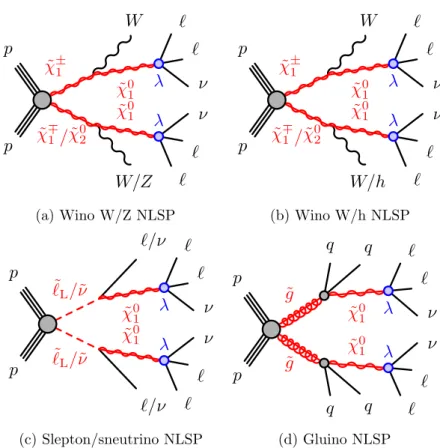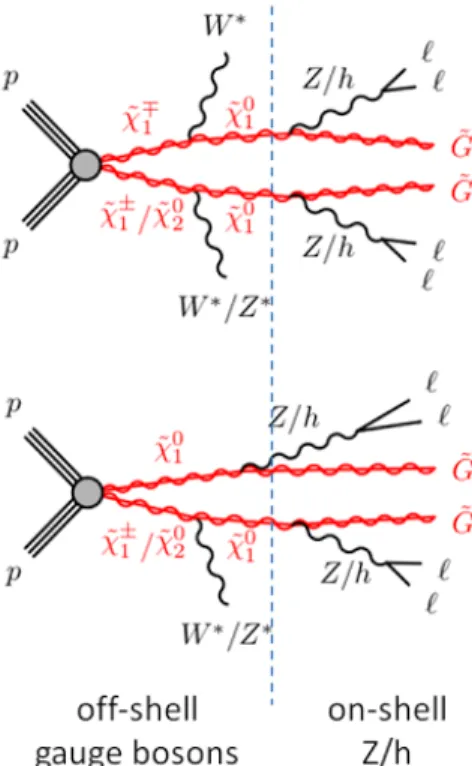Technischen Universit¨ at M¨ unchen Fakult¨ at f¨ ur Physik
Habilitation Thesis
Search for Supersymmetry with the ATLAS detector at the LHC
Zinonas Zinonos
M¨ unchen, 2019
Habilitation Thesis ”Search for Supersymmetry with the ATLAS detector at the LHC”.
Experimental High Energy and Particle Physics.
Max-Planck-Institut f¨ ur Physik & Technischen Universit¨ at M¨ unchen.
M¨ unchen, 2017-2019.
Defended on December 12, 2019.
Submitted in March, 2020.
Mentoring committee:
Prof. Dr. Hubert Kroha (Max-Planck-Institut f¨ ur Physik, M¨ unchen, Chair)
Prof. Dr. Stephan Paul (Technischen Universit¨ at M¨ unchen, Member)
Prof. Dr. Gregor Herten (Universit¨ at Freiburg, Member)
3
Acknowledgements
First and foremost, I would like to express my sincere gratitude to my advisor Prof. Dr.
Hubert Kroha (Max-Planck-Institut f¨ ur Physik, M¨ unchen) for the continuous support on my habilitation project and related research as well as for his professionalism, motivation, and immense scientific knowledge. His insightful guidance and encouragement helped me in all the time of research and completion of this effort. I could not have imagined having a better advisor and mentor for my Habilitation.
Besides my advisor, I would like to express my gratitude to the rest of my Habilitation Committee: Prof. Dr. Stephan Paul (Technischen Universit¨ at M¨ unchen, chairman of the committee) and Prof. Dr. Gregor Herten (Universit¨ at Freiburg), who provided me extensive guidance to achieve the scientific goals of this thesis. Also, I am grateful to all colleagues with whom I have had the pleasure to work during this and other related projects.
A very special gratitude goes to Prof. Dr. Siegfried Bethke, director at the Max Planck Institute for Physics in Munich, for encouraging and supporting me to pursue the habilitation program.
Most importantly, I am deeply indebted to my loving, caring and supportive wife,
Louiza, and my three wonderful daughters, Marina, Arsenia and Akylina, who endlessly
provide me unending inspiration.
Contents
1 Introduction 7
1.1 Motivation for Supersymmetry . . . . 7
1.2 Minimal Supersymmetric Standard Model . . . . 9
1.3 R-Parity . . . . 10
1.4 Phenomenology of Supersymmetry . . . . 11
1.5 Experimental Search Program for SUSY . . . . 12
1.6 Scope of Thesis . . . . 13
2 ATLAS Detector 17 2.1 Coordinate System . . . . 18
2.2 Inner Detector . . . . 18
2.3 Calorimeters . . . . 18
2.4 Muon Spectrometer . . . . 19
2.5 Trigger System . . . . 20
2.6 Luminosity . . . . 20
3 Searches and Methodology 23 3.1 Search for SUSY in multileptonic final states . . . . 23
3.1.1 Motivation . . . . 23
3.1.2 Scenarios . . . . 24
3.1.3 Methodology . . . . 27
3.1.4 Results . . . . 28
3.2 Conclusions . . . . 30
3.3 Search for direct stau lepton production . . . . 33
3.3.1 Motivation . . . . 33
3.3.2 Methodology . . . . 35
3.3.3 Results . . . . 36
3.3.4 Conclusions . . . . 37
4 Synopsis 39 4.1 Summary . . . . 39
4.2 Outlook . . . . 40
5
5 Appendix 51
Chapter 1
Introduction
1.1 Motivation for Supersymmetry
For several decades, particle physicists having been trying to better understand Nature at the smallest distances by colliding particles at the highest energies. While the Standard Model (SM) of particle physics has successfully explained most of the results that have arisen from experiments, many phenomena remain baffling.
Supersymmetry, commonly abbreviated as SUSY, is one of the most appealing ex- tensions of the SM. It is a generalization of the space-time symmetries of quantum field theory that proposes a relationship between two basic classes of elementary parti- cles: bosons, which live in an integer-valued angular momentum eigenstate (spin), and fermions, which have a half-integer spin. Each particle from one group would have an associated particle in the other, which is known as its superpartner, the spin of which differs by a half-integer.
There are numerous phenomenological motivations for SUSY close to the electroweak scale, as well as technical motivations for this theory at any energy scale.
First, SUSY provides a framework for the unification of particle physics and grav- ity [1–3] at the Planck energy scale, M
P∼ 10
19GeV, where the gravitational interactions become comparable in magnitude to the gauge interactions. Moreover, SUSY can pro- vide an explanation of the large hierarchy between the energy scale that characterizes electroweak symmetry breaking, M
EW∼ 100 GeV, and the Planck scale [4–7]. The stability of this large gauge hierarchy with respect to radiative quantum corrections is not possible to maintain in the SM without an unnatural fine-tuning of the parameters of the fundamental theory at the Planck scale. More specifically, in a theory such as the SM with an elementary scalar field of mass m and interaction strength λ (e.g. the quartic scalar self-coupling; the square of a gauge coupling or the square of a Yukawa coupling), the stability with respect to quantum corrections requires the existence of an energy cutoff roughly of order p
(4π)
2/λ m beyond which new physics must enter [8].
A significantly larger energy cutoff would require an unnatural fine-tuning of param- eters that govern the low-energy theory. Applying this argument to the SM leads to an expectation of new physics at the TeV scale. In a supersymmetric extension of the
7
Figure 1.1: Two-loop renormalization group evolution of the inverse gauge couplings α
−1a(Q) a = 1; 2, 3 as a function of the energy scale Q in the SM (dashed lines) and the MSSM (solid lines). Unlike the SM, the MSSM includes just the right particle content to ensure that the gauge couplings can unify, at a scale M
U∼ 1.5 × 10
16GeV. Adapted from Ref. [1].
SM, thereby, it is possible to maintain the gauge hierarchy while providing a natural framework for elementary scalar fields.
Second, the unification of the three SM gauge couplings at a very high energy close to the Planck scale is possible if new physics beyond the SM (which modifies the running of the gauge couplings above the electroweak scale) is present. The minimal supersym- metric extension of the SM (MSSM), where superpartner masses lie below a few TeV, provides an example of successful gauge coupling unification [9].
Third, the existence of dark matter (DM), which makes up approximately one quarter of the energy density of the universe, cannot be explained within the SM of particle physics [10]. Remarkably, a stable weakly-interacting massive particle (WIMP) whose mass and interaction rate are governed by new physics associated with the TeV-scale can be consistent with the observed density of dark matter, the so-called WIMP miracle,.
The lightest supersymmetric particle, if stable, is a promising (although not the unique) candidate for the DM [11–13].
If SUSY were an exact symmetry of nature, then particles and their superpartners
would be degenerate in mass. Since superpartners have not (yet) been observed by
experiments, SUSY must be a broken symmetry. Despite the break down of SUSY, the
stability of the gauge hierarchy can still be maintained if the SUSY breaking is soft [14,
15], and the corresponding SUSY-breaking mass parameters are no larger than a few
TeV. This, in fact, makes the search of SUSY plausible at modern collider experiments
since it lies within the energy reach, for example, the Large Hadron Colllider (LHC) at
1.2. MINIMAL SUPERSYMMETRIC STANDARD MODEL 9
Figure 1.2: Particle content of the Minimal Supersymmetric SM theory.
CERN located in Geneva.
1.2 Minimal Supersymmetric Standard Model
In its minimal realization, the MSSM, SUSY postulates the existence of a new bosonic (fermionic) partner for each fundamental SM fermion (boson), as well as an additional Higgs doublet. More specifically, electroweakly interacting supersymmetric particles are charginos, neutralinos, sleptons, sneutrinos and squarks. Charginos ( ˜ χ
±) and neutralinos ( ˜ χ
0) are the mass eigenstates formed by linear combinations of the superpartners of the charged and neutral Higgs bosons and of the electroweak gauge bosons. Strongly interacting superpartners are the squarks (˜ q) and gluinos (˜ g).
The minimal supersymmetric extension of the SM also consists of the fields of the two-Higgs-doublet extension of the SM and the corresponding superpartners. After elec- troweak symmetry breaking, five Higgs bosons arise, of which two are charged. The supersymmetric partners of the Higgs doublets are known as ”higgsinos”. The enlarged Higgs sector of the MSSM constitutes the minimal structure needed to guarantee the cancellation of gauge anomalies [16] generated by the higgsino superpartners that can ap- pear as internal lines in triangle diagrams with three external electroweak gauge bosons.
Moreover, without a second Higgs doublet, one cannot generate mass for both ”up”-type and ”down”-type quarks, and charged leptons in a way consistent with the underlying SUSY [17, 18].
The fact that such particles are not yet observed leads to the conclusion that, if
SUSY is realized, it is a broken symmetry. A description of SUSY in the form of an
effective Lagrangian with only ”soft” SUSY breaking terms and SUSY masses at the
TeV scale maintains cancellation of quadratic divergences in particle physics models
1.3 R-Parity
In the absence of a protective symmetry, SUSY processes violating the lepton (L) and baryon (B) quantum numbers result in proton decay at a rate that is in conflict with the experimental constraints on its lifetime. This conflict can be avoided by imposing a B − L conservation requirement on the supersymmetric Lagrangian when defining the MSSM. As a consequence of the B − L symmetry, the MSSM possesses a multiplicative R-parity invariance, which is defined as
R = (−1)
3(B−L)+2S(1.1)
for a particle of spin S [19]. This implies that all the particles of the SM have even R-parity, whereas the corresponding superpartners have odd R-parity.
u
d
u u
e u *
+ sR*
~
R
R L
L 0
p
Figure 1.3: Proton decay into a positron and a neutral pion.
The conservation of R-parity in scattering and decay processes has a critical im- pact on supersymmetric phenomenology. For example, any initial state in a scattering experiment will involve ordinary (R-even) particles. Consequently, it follows that su- persymmetric particles must be produced in pairs. In general, these particles are highly unstable and decay into lighter states. R-parity invariance also implies that the lightest supersymmetric particle (LSP) is absolutely stable, and must eventually be produced at the end of a decay chain initiated by the decay of a heavy unstable supersymmetric par- ticle. In order to be consistent with cosmological constraints, a stable LSP is certainly electrically and color neutral [12]. Therefore, the LSP in an R-parity-conserving (RPC) theory is weakly interacting with ordinary matter, i.e., it behaves like a stable heavy neutrino and will escape collider detectors without being directly observed. Thus, the canonical signature for conventional RPC supersymmetric theories is substantial miss- ing (transverse) energy, due to the LSP escaping from any detection means. Finally, the stability of the LSP in RPC SUSY makes it a promising candidate for dark matter.
If R-parity is violated, new lagrangian terms parameterized by λ
ijk, λ
0ijkand λ
00ijkappear in the superpotential, where ijk are particle generation indices.
W = λ
ijkL
iL
jE ¯
k+ λ
0ijkQ
iL
jD ¯
k+ λ
00ijkU ¯
iD ¯
jD ¯
k+ m
iL
iH
u(1.2)
where Q, U, D, L, E are the matter superfields and H
u,dare the up and down type
Higgs superfields. The λ-type couplings appear between lepton superfields only, λ
0-type
are between quark superfields only, and λ
00-type couplings connect the two. R-parity
violation (RPV) implies lepton and/or baryon number violation. In this case, the lightest
1.4. PHENOMENOLOGY OF SUPERSYMMETRY 11 neutralino can decay even if it is the LSP. If the decay involves a non-zero λ coupling, the final state will be a multi-lepton one. Searches for events with four or more isolated charged leptons by the ATLAS [20–22] and CMS [23] experiments are interpreted in such models. The search of multi-lepton final states and interpretation in SUSY RPV models is subject of this thesis. With very small coupling values, the neutralino would be long-lived, leading to lepton pairs with a displaced vertex, which have also been searched for [24, 25].
1.4 Phenomenology of Supersymmetry
The phenomenology of SUSY is to a large extent determined by the SUSY breaking mechanism and the SUSY breaking scale. This determines the SUSY particle masses, the mass hierarchy, the field contents of physical particles, and their decay modes. In ad- dition, phenomenology crucially depends on whether the multiplicative quantum number of R-parity is conserved or violated. In most cases, supersymmetric events are charac- terized by a high multiplicity of final state particles and a large amount of missing transverse energy due to the undetected LSP and possible production of neutrinos.
Since the mechanism by which SUSY is broken is unknown, a general approach to SUSY via the most general soft SUSY breaking Lagrangian adds a significant number of new free parameters. For the MSSM, these comprise 105 new parameters. A phenomeno- logical analysis of SUSY searches leaving all these parameters free is not feasible. For the practical interpretation of SUSY searches at colliders, several approaches are taken to reduce the number of free parameters. The most common approach is to assume a SUSY breaking mechanism and lower the number of free parameters through the assumption of additional constraints, such the R-parity conservation or not, the particle masses and decay branching ratios.
At the LHC, most searching approaches are developed to increase the sensitivity to pair production of heavy sparticles with TeV-scale masses focusing on the kinematics of their decays, and to further suppress the background from SM processes.
Selection variables designed to separate the SUSY signal from the SM backgrounds typically include H
T, E
Tmiss, and m
eff. The reconstructed quantities H
Tand E
Tmissre- fer to the measured transverse energy and missing transverse momentum in the event, respectively. They are defined as the scalar sum of the transverse particle momenta or calorimeter clusters transverse energies measured in the event (H
T), or the negative vector sum of transverse momenta of reconstructed objects like jets and leptons in the event (E
missT). The event observable m
effis referred to as the effective mass of the event and is defined as the sum of H
Tand E
Tmiss. The peak of the m
effdistribution for SUSY signal events correlates with the SUSY mass scale, in particular with the mass difference between the primary produced SUSY particle and the LSP, whereas the SM backgrounds typically dominate at low m
effvalues. Additional reduction of multijet backgrounds can be achieved by requiring isolated leptons or photons in the final states.
Recently, alternative approaches have been developed to increase the sensitivity to
pair production of heavy sparticles with TeV-scale masses focusing on the kinematics of
their decays, and to further suppress the background from multijet production. Promi- nent examples of these new approaches are searches using the α
Tvariable [26, 27], razor variables [28], stransverse mass (m
T2) [29], and contransverse mass (m
CT) [30]. In par- ticular, a lower bound on the stransverse mass can be imposed in event selections to reduce contributions from t ¯ t and W W events. The m
T2variable is defined as:
m
T2= min
qT
h max
m
(1)T(p
(1)T, q
T), m
(2)T(p
(2)T, E
missT− q
T) i
, (1.3)
where p
(i)T, i = 1, 2 are the transverse momenta of a reconstructed particle pair, and q
Tis the transverse momentum vector that minimizes the larger of the two transverse masses m
(i)T, i = 1, 2. The latter masses are defined by
m
T(p
T, q
T) = p
2(p
Tq
T− p
T· q
T) . (1.4) For t ¯ t and W W events, in which two W bosons decay leptonically and E
missTis the sum of the transverse momenta of the two neutrinos, the m
T2distribution has a kinematic end-point at the W mass. For large mass differences between the staus and the lightest neutralino, the m
T2distribution for signal events extends significantly beyond this end- point.
Furthermore, the topological event reconstruction methods have expanded with the superrazor [31] and recursive jigsaw reconstruction [32] techniques. Finally, the searches including massive SUSY particles attempt to identify their decay into top quarks or vector bosons, which are themselves unstable. If these are produced with a significant boost, jets(tau lepton) from their decay will typically overlap, and such topologies are searched for with jet(tau lepton)-substructure techniques [33].
1.5 Experimental Search Program for SUSY
Searches for SUSY and new physics in general were part of the physics program of large collider experiments, such as the LEP electron-positron collider at CERN, the Tevatron proton-antiproton collider at Fermilab, the HERA electron-proton collider at DESY, and the LHC proton-proton (pp) collider at CERN.
Searches for new physics at e
+e
−colliders benefit from the clean experimental envi-
ronment and the fact that momentum balance can be measured not only in the plane
transverse to the beam, but also in the direction along the beam pipe, defined as the
longitudinal direction. Searches at LEP are dominated by the data samples taken at
the highest center-of-mass energies. On the other hand, proton-(anti)proton colliders
produce interactions at higher center-of-mass energies than those available at LEP, and
cross sections of QCD-mediated processes are larger, which is reflected in the higher sen-
sitivity for SUSY particles carrying color charge: squarks and gluinos. Large background
contributions from SM processes, nonetheless, pose challenges to data acquisition and
analysis. Such backgrounds are dominated by QCD multijet production processes, the
top quark production, as well as jet production in association with vector gauge bosons.
1.6. SCOPE OF THESIS 13 The proton momentum is shared between its parton constituents, and in each collision only a fraction of the total center-of-mass energy is available in the hard parton-parton scattering. Since the parton momenta in the longitudinal direction are not known on an event-by-event basis, use of momentum conservation constraints in an analysis is re- stricted to the transverse plane, leading to the definition of transverse variables, such as the missing transverse energy E
Tmiss, and the transverse mass m
T.
Today, there is no evidence to show whether or not SUSY is correct, or what other extensions to current supersymmetric models might be more accurate. Despite this, SUSY is being supported by physicists since it remains the most complete theory to describe possible phenomena beyond the SM. Low-energy data from flavor physics ex- periments, high-precision electroweak observables as well as astrophysical data impose strong constraints on the allowed SUSY parameter space. Recent examples of such data include measurements of the rare B-meson decay B
s→ µ
+µ
−[34, 35], measurements of the anomalous magnetic moment of the muon [36], and accurate determinations of the cosmological dark matter relic density constraint [37].
These indirect constraints are often more sensitive to higher SUSY mass scales than experiments searching for direct sparticle production at colliders, but the interpretation of these results is often strongly model dependent. On the other hand, direct confir- mation would entail production of superpartners in collider experiments, such as the LHC. Direct searches for sparticle production at collider experiments are less subject to interpretation ambiguities and therefore they play a crucial role in the search for SUSY.
The first runs of the LHC found no previously-unknown particles other than Higgs boson with a mass around 125 GeV, which was already suspected to exist as part of the SM. With the discovery of the Higgs boson, further constraints were imposed on a plethora of SUSY models [38].
1.6 Scope of Thesis
This habilitation thesis attempts to cover searches from the electroweak sector of SUSY, mostly involving leptons in the final state. The electroweak processes are characterized by a very small production cross-section, at minimum one order of magnitude less than those processes involving the strong force, as presented by Figure 1.4. Due to exactly the colored production of gluinos and squarks, the SUSY partners of gluons and quarks, hadron collider experiments are able to set much tighter mass limits. Despite this fact, the search for SUSY in electroweak scenarios is also feasible due the distinct signal sig- natures in the event final state which suppress significantly the SM background sources.
For example, the search of multileptonic final states requires the presence many leptons in the event, and the search of direct production of tau sleptons require high values of the m
effobservable. Both selection requirements reduce significantly the SM processes that mimic these SUSY signal events. The search of these SUSY scenarios consist the main topic of this thesis, which presents the methodology and discusses the main results.
Since none of the searches performed so far have shown significant excess above the SM
background prediction, the interpretation of the presented results is focused on showing
Figure 1.4: Cross sections for pair production of different SUSY production modes as a function of the sparticle mass at the LHC for a center-of-mass energy of 13 TeV.
The cross section of pair production of electroweak gauginos at the LHC, for masses of
several hundreds of GeV, is at least two orders of magnitude smaller than for colored
SUSY particles (e.g. top squark pair production). Adapted from Ref. [39].
1.6. SCOPE OF THESIS 15 exclusion limits on the SUSY parameter space.
In the following, the ATLAS detector at the LHC is shortly described. Then, the
main ingredients of the analysis structure and result interpretation are presented, as well
as the conclusions of each search. Whereas necessary, the assumptions that have entered
the limits when quoting interpretations from simplified models will be explicitly pointed
out. The papers accepted for publication or already published in electronic journals are
enclosed in the Appendix 5.
Chapter 2
ATLAS Detector
The ATLAS detector [40], shown in Figure 2.1, is a multipurpose particle detector with a forward-backward symmetric cylindrical geometry and nearly 4π coverage in solid angle. The entire detector weighs approximately 7,000 tons, and is 44 m long and 25
Figure 2.1: Cutaway drawing of the ATLAS detector showing its main detection com- ponents.
m in diameter. It is situated in an underground cavern at a depth of 100 m, where it surrounds one of the collision points around the 27-km-long LHC ring. The first pp collisions at the LHC were recorded in 2009, and since then collider has operated at different center-of-mass-energies, namely 7, 8 and 13 TeV.
17
2.1 Coordinate System
ATLAS uses a right-handed coordinate system with its origin at the nominal interaction point (IP) in the center of the detector and the z-axis along the beam pipe. The x- axis points from the IP to the center of the LHC ring, and the y-axis points upward.
Cylindrical coordinates (r, φ) are used in the transverse plane, φ being the azimuthal angle around the z-axis. Pseudorapidity, η, is defined in terms of the polar angle θ as η = − ln tan(θ/2). Rapidity is defined as y = 0.5 ln(E + p
z)/(E − p
z) where E denotes the energy and p
zis the component of the momentum along the beam direction.
2.2 Inner Detector
The inner tracking detector (ID) consists of silicon pixel detector and semiconductor tracker (SCT) detectors covering the pseudorapidity region |η| < 2.5. These systems are surrounded by a transition radiation tracker (TRT), which enhances electron iden- tification in the region |η| < 2.0. Before LHC Run 2, a new innermost pixel layer, the insertable B-layer [41], was inserted at a mean sensor radius of 3.3 cm. The ID is
Figure 2.2: Cut-away image of the ATLAS Inner Detector.
surrounded by a thin superconducting solenoid providing an axial 2 T magnetic field.
2.3 Calorimeters
A fine granularity lead/liquid-argon (LAr) electromagnetic (EM) calorimeter, covering
|η| < 3.2, is used to reconstruct electrons and photons. A steel/scintillator tile calorime-
ter provides coverage for hadronic showers in the central pseudorapidity range (|η| < 1.7).
2.4. MUON SPECTROMETER 19 The endcaps (1.5 < |η| < 3.2) of the hadronic calorimeter have LAr active layers with either copper or tungsten as the absorber material. The forward region (3.1 < |η| < 4.9) is instrumented with a LAr calorimeter for both the EM and hadronic measurements.
2.4 Muon Spectrometer
The ATLAS muon spectrometer (MS) is cylindrical, 22 m in diameter and 45 m in length, surrounding the calorimeters with an acceptance coverage of 2π in azimuth and
±2.7 in pseudorapidity. It is designed to detect muons in the pseudorapidity region up to |η| = 2.7, and to provide momentum measurements with a relative resolution δp/p better than 3% over a wide p
Trange and up to 10% at p
T' 1 TeV [42].
The MS consists of one barrel (|η| < 1.05) and two endcap sections (1.05 < |η| < 2.7).
A system of three large superconducting air-core toroidal magnets, each with eight coils, provides a magnetic field with a bending integral B · dl of about 2.5 T · m in the barrel and up to 6 T · m in the endcaps. Resistive plate chambers (RPC, three doublet layers for |η| < 1.05) and thin gap chambers (TGC, one triplet layer followed by two doublets for 1.0 < |η| < 2.4) provide triggering capability to the detector as well as (η, φ) position measurements with typical spatial resolution of 5−10 mm. A precise momentum measurement for muons with pseudorapidity up to |η| = 2.7 is provided by three layers of monitored drift tube chambers (MDT), with each chamber providing six to eight η measurements along the muon trajectory. For |η| > 2, the inner layer is instrumented with a quadruplet of cathode strip chambers (CSC) instead of MDTs. The single-hit resolution in the bending plane for the MDT and the CSC is about 80 µm and 60 µm, respectively. The muon chambers are aligned with a precision between 30 µm and 60 µm.
Figure 2.3: Cross-sectional view of the ATLAS muon spectrometer.
2.5 Trigger System
The ATLAS trigger system [43] consists of a hardware-based level-1 (L1) trigger followed by a software-based high-level trigger (HLT).
The L1 hardware trigger is constructed with custom-made electronics and runs with a fixed latency of 2.5 µs. It works on a subset of information from the calorimeter and muon detectors. The decision to keep the data from an event is made less than two-and-half microseconds after the event occurs, and the event is then retrieved from pipelined storage buffers. The L1 trigger reduces substantially the event rate from the LHC interaction rate of 40 MHz, and can save at most 100 k events per second for the HLT.
The HLT software trigger-based trigger is assembled by a large farm of CPUs and serves to refine the analysis of the L1 trigger. In the HLT, offline-like reconstruction al- gorithms run in a large farm of ∼ 40k processor cores and a decision is formed typically within 300 ms. It conducts a very detailed analysis either by performing overall exam- ination of the whole event for selected layers of the detector (for example calorimeters, trackers, muon detectors), or, by utilizing the data in smaller and isolated regions of the detector. About 1k events per second are selected by the HLT analysis and are fully assembled into an event record. These events are finally passed on to a data storage system for offline analysis.
2.6 Luminosity
A precise measurement of the integrated luminosity is a key component of the ATLAS physics program, in particular for cross-section measurements where it is often one of the leading sources of uncertainty [44]. The luminosity measurement is based on an absolute calibration of the primary luminosity-sensitive detectors in low-luminosity runs with specially-tailored LHC conditions using the van der Meer (vdM) method [45]. The total uncertainties on the integrated luminosity measurements for each individual year of data-taking range from 2.0 to 2.4%, and are partially correlated between years.
Figures 2.4 and 2.5 presents the cumulative luminosity versus day delivered to AT-
LAS during stable beams and for high energy pp collisions. After typical data-quality
selections, the full Run 2 pp data sample corresponds to an integrated luminosity of
139 fb
−1, with an uncertainty of 1.7%.
2.6. LUMINOSITY 21
Figure 2.4: Delivered luminosity to ATLAS for pp collisions versus time for years 2011- 2018 [46].
Figure 2.5: Cumulative luminosity versus time delivered to ATLAS (green), recorded by
ATLAS (yellow), and certified to be good quality data (blue) during stable beams for
pp collisions at 13 TeV centre-of-mass energy in 2015-2018.
Chapter 3
Searches and Methodology
3.1 Search for SUSY in multileptonic final states
3.1.1 Motivation
Multileptonic final states consist a very attractive channel for the search for new physics at the LHC because the overwhelming hadronic background can be strongly suppressed.
In RPV models, the lightest SUSY particle is unstable and decays to SM particles, including charged leptons and neutrinos when violating L but not B. In RPC models, the LSP is stable and leptons can originate from unstable weakly interacting sparticles decaying into the LSP. Therefore, both the RPV and RPC SUSY scenarios can result in signatures with high lepton multiplicities and substantial missing transverse momentum.
Requiring a high multiplicity of isolated leptons (electrons and muons - including those originating from leptonic tau decays - and hadronically decaying taus), allows any new signature to be cleanly separated from the otherwise overwhelming hadron-rich background processes, typical of high-energy pp collisions, even if its cross-section is small.
More specifically, within this habilitation program, multiple searches for the produc- tion of charginos, neutralinos, sleptons and gluinos decaying to final states with at least four charged leptons are conducted. These searches exploit the complete pp collision dataset delivered by the LHC at a center-of-mass energy of √
s = 13 TeV, and collected and reconstructed with the ATLAS detector. Particular emphasis is placed on the search for light higgsino particles. The exclusion of gluino and stop masses up to the TeV mass scale qualifies now the light higgsinos to be discovered first at LHC, as motivated by naturalness. In General Gauge Mediated (GGM) SUSY models, the gravitino (super- symmetric particle of graviton) is nearly massless and is the LSP offering the possibility to study light higgsinos. Typical higgsino signal events are characterized by multiple charged leptons substantial MET, which is a distinct signature used to identify higgsino events.
The search itself is optimized using several signal models but is generally model- independent using loose requirements on effective mass or missing transverse energy.
23
Results are presented in terms of the number of events from new physics processes with a four charged lepton signature, and in particular in terms of RPC or RPV simplified models with decays of the LSP to charged leptons.
3.1.2 Scenarios
Simplified models of RPV scenarios are considered, where the LSP is a bino-like neu- tralino ( ˜ χ
01) and decays via an RPV interaction. The LSP decay is described by the
1
2
λ
ijkL
iL
jE ¯
klepton-number-violating superpotential term, where L
iand E
iindicate the lepton SU(2)-doublet superfield and singlet superfield, respectively. Lepton generations are referred to by the indices i, j and k while λ
ijkcorresponds to nine Yukawa couplings which allow the decay of the LSP to every possible combination of charged lepton pairs.
In this search, two extremes of the λ
ijkRPV couplings are considered: L
1L
2E ¯
k(k = 1, 2) where only decays to electrons and muons are considered, and L
iL
3E ¯
3(i = 1, 2) where only decays to taus and either electrons or muons are included.
Three different RPV scenarios are searched in this thesis for the next-to-lightest- supersymmetric particle (NLSP) in the L
1L
2E ¯
k(λ
12k) and L
iL
3E ¯
3(λ
i33):
1. Wino NLSP, where mass-degenerate wino-like charginos and neutralinos are pro- duced in association;
2. Slepton/sneutrino NLSP, where mass-degenerate left-handed sleptons and sneutri- nos of all three generations are produced in association; and
3. Gluino NLSP, where the produced gluinos decay to the LSP while emitting a quark-antiquark pair each.
These scenarios, as diagrammatically shown in Figure 3.1, result typically in signa- tures with high lepton multiplicities and substantially high values of the the effective mass observable, m
eff. These features of the final state can be used to select signal events while suppressing the SM background drastically.
This analysis is also optimized to search RPC scenarios with light ˜ χ
01, ˜ χ
02, ˜ χ
±1hig- gsino triplet states in the context of GGM, which predicts the gravitino ( ˜ G, the fermionic superpartner of the graviton) nearly massless giving the opportunity to study light hig- gsinos (shown in Figure 3.2). Light higgsinos are well motivated by naturalness [47, 48].
Typically, the members of the higgsino triplet are close in mass its decays result in low-momentum decay products that are difficult to reconstruct efficiently. However, the decays of the higgsinos themselves to the LSP ˜ G would lead to on-shell Z/h, and the decay products can be therefore efficiently reconstructed, as illustrated in Figure 3.3.
In this search, simplified RPC models inspired by GGM are considered, where the only SUSY particles within reach of the LHC are an almost mass-degenerate higgsino triplet
˜
χ
01, ˜ χ
02, ˜ χ
±1and a massless ˜ G. Finally, the ˜ χ
01→ Z G ˜ branching ratio is a free parameter of
the GGM higgsino scenarios, and so offers an opportunity to study four-lepton signatures
with one or more Z-boson candidates.
3.1. SEARCH FOR SUSY IN MULTILEPTONIC FINAL STATES 25
˜ χ
±1˜ χ
∓1/ ˜ χ
02˜ χ
01˜ χ
01p
p
W
λ
`
`
ν
W/Z λ
`
` ν
(a) Wino W/Z NLSP
˜ χ
±1˜ χ
∓1/ ˜ χ
02˜ χ
01˜ χ
01p
p
W
λ
`
`
ν
W/h λ
`
` ν
(b) Wino W/h NLSP
` ˜
L/˜ ν
` ˜
L/˜ ν
˜ χ
01˜ χ
01p
p
`/ν
λ
`
`
ν
`/ν λ
`
` ν
(c) Slepton/sneutrino NLSP
˜ g
˜ g
˜ χ
01˜ χ
01p
p
q q
λ
`
`
ν
q q
λ
`
` ν
(d) Gluino NLSP
Figure 3.1: Diagrams of the processes in the SUSY RPV models considered in the
analysis.
Figure 3.2: Diagrams of the processes in the GGM higgsino models considered in the analysis.
Figure 3.3: Chart illustrating the decay chain of the higgsino triplet ˜ χ
01, ˜ χ
02, ˜ χ
±1to a
nearly massless gravitino, ˜ G, LSP. The decays of the higgsinos to the LSP would lead
to on-shell Z/h, and the decay products can be thus reconstructed.
3.1. SEARCH FOR SUSY IN MULTILEPTONIC FINAL STATES 27 3.1.3 Methodology
Events are selected using single-lepton or dilepton triggers, where the trigger efficiencies are in the plateau region above the offline p
Tthresholds. The latter are typically a bit higher than the online ones. Dilepton triggers are used only when the leptons in the event fail p
T-threshold requirements for the single-lepton triggers.
Events with four or more signal leptons (` = e, µ and hadronically decaying τ
had−vis) are selected and are classified according to the number of light signal leptons (L = e, µ) and signal taus (T): at least four light leptons and exactly zero taus 4L0T, exactly three light leptons and at least one tau 3L1T, or exactly two light leptons and at least two taus 2L2T .
Events are further classified according to whether they are consistent with a leptonic Z boson decay or not. The Z-boson requirement selects events where any same-flavor LL pair combination with opposite electric charge (SFOS) has an invariant mass close to the Z-boson mass, in the range 81.2 − 101.2 GeV. A second Z candidate may be identified if a second SFOS LL pair is present and satisfies 61.2 < m(LL) < 101.2 GeV. To suppress radiative Z boson decays into four leptons (where a photon radiated from a Z → ``
decay converts to a second SFOS lepton pair) the Z veto also considers combinations of any SFOS LL pair with an additional lepton (SFOS+L), or with a second SFOS LL pair (SFOS+SFOS), and rejects events where either the SFOS+L or SFOS+SFOS invariant mass lies in the range 81.2 − 101.2 GeV.
In order to separate the SM background from SUSY signal, the E
Tmissand the effective mass of the event, m
eff, are both used. More precisely, the m
effis constructed as the scalar sum of the E
Tmiss, the p
Tof signal leptons and the p
Tof all jets above 40 GeV (in order to suppress jets stemming from pileup events and the underlying event).
Two signal regions (SR) are defined with 4L0T and a Z-boson veto: a general, model- independent signal region (SR0A) with m
eff> 600 GeV, and a tighter signal region (SR0B) with m
eff> 1.1 TeV, optimized for the RPV LL E ¯
12kscenarios. Two further SRs are defined with 4L0T, a first and second Z requirement and different selections on E
Tmiss: a loose signal region (SR0C) with E
Tmiss> 40 GeV, and a tighter signal region (SR0D) with E
Tmiss> 100 GeV, optimized for the low-mass and high-mass higgsino GGM scenarios, respectively. Finally, two SRs are optimized for the tau-rich RPV LL E ¯
i33scenarios: one with 3L1T where the tau has p
T> 30 GeV, a Z veto and m
eff> 700 GeV (SR1), and a second with 2L2T where the taus have p
T> 30 GeV, a Z veto and m
eff> 650 GeV (SR2). All signal regions deployed in the search are diagrammatically shown by Figure 3.4.
The main background processes of this search are classified into two categories:
1. irreducible background consisting of hard-scattering processes giving rise to events with four or more real leptons (e.g. ZZ and t ¯ tZ); and
2. reducible background consisting of processes leading to events with at least one fake lepton (e.g. t ¯ t, Z+jets and WW).
The irreducible backgrounds are estimated from Monte Carlo (MC) simulation, while
the reducible backgrounds are derived from data with the so-called fake-factor method.
Figure 3.4: Signal regions targeting RPV and RPC SUSY signal events. SR0A, SR0B, SR1 and SR2 target SUSY events in RPV scenarios, while SR0C and SR0D are designed to be sensitive to GGM higgsino SUSY events.
In the fake-factor method, the number of reducible background events in a given region is estimated from data using probabilities for a fake charged lepton (e, µ and hadronically decayin τ ’s) to pass or fail the signal lepton selection. The ratio F = f / f ¯ for fake leptons is the ”fake factor”, where f ( ¯ f ) is the probability that a fake lepton is misidentified as a signal (”loose”) lepton. The probabilities used in the fake-factor calculations are based on simulation and corrected to data where possible. Loose leptons are leptons surviving the geometrical overlap removal with respect to other reconstructed particles in the event, that do not satisfy signal lepton criteria. The reducible background prediction is extracted by applying fake factors to control regions (CR) in data. The CR definition only differs from that of the associated SR in the quality of the required leptons. Finally, the predictions for irreducible and reducible backgrounds are tested in validation regions (VR).
Several sources of systematic uncertainty are considered for the SM background esti- mates and signal yield predictions. The systematic uncertainties affecting the simulation- based estimate can be divided into three components: MC statistical uncertainty, sources of experimental uncertainty (from identified physics objects e,µ, τ and jets, and also E
Tmiss), and sources of theoretical uncertainty. The reducible background is affected by different sources of uncertainty associated with data counts in control regions and uncer- tainties in the weighted fake factors. The MC statistical uncertainty for the simulation- based background estimate is small and less than 7% of the total background estimate in all signal regions. Systematic uncertainties in the SUSY signal yields from experimental and theoretical sources are typically of the order of 10% each.
3.1.4 Results
In general, the observed yields in each signal region are found to be consistent with the SM expectations within a local significance of at most ∼ 1σ.
In order to quantify the probability for the background-only hypothesis to fluctuate to
the observed number of events or higher, a one-sided p
0-value is calculated using pseudo-
experiments, where the profile likelihood ratio is used as a test statistic to exclude the
3.1. SEARCH FOR SUSY IN MULTILEPTONIC FINAL STATES 29 signal-plus-background hypothesis. A signal model can be excluded at 95% confidence level (CL) if the CL
sof the signal-plus-background hypothesis is below 0.05. The 95%
CL upper limits on the signal cross section times efficiency and the CL
bvalue for the background-only hypothesis are also calculated for each signal region.
The number of observed events in each signal region is used to set exclusion limits in the SUSY models, where the statistical combination of all disjoint signal regions is used. Since SR0A and SR0B are overlapping signal regions, the one with the better expected exclusion is used in the combination. For the exclusion limits, the observed and expected 95% CL limits are calculated by performing pseudo-experiments for each SUSY model point, taking into account the theoretical and experimental uncertainties in the SM background and the experimental uncertainties in the signal. For all expected and observed exclusion limit contours, the ±1σ
expuncertainty band indicates the impact on the expected limit of the systematic and statistical uncertainties included in the fit.
The ±1σ
theorySUSYuncertainty lines around the observed limit illustrate the change in the observed limit as the nominal signal cross section is scaled up and down by the theoretical cross section uncertainty.
Figure 3.5 shows the exclusion contours for the RPV models considered in the search.
The exclusion limits in the RPV models extend to high masses due to the high lepton multiplicity in these scenarios and the high efficiency of the m
effselections. Wino-like
˜
χ
±1/ χ ˜
02, slepton/sneutrino and gluino masses up to 1.46 TeV, 1.06 GeV, and 2.25 TeV are excluded, respectively.
The results are also interpreted in simplified higgsino GGM models, where higgsino- like ˜ χ
±1/ χ ˜
02/ χ ˜
01masses up to 295 GeV are excluded in scenarios with a 100% branching ratio for ˜ χ
01decay to a Z boson and a gravitino (Figure 3.6).
Searches for higgsinos within gauge-mediated scenarios can be performed in final states with different decay products as well, such as b-flavor jets, as illustrated in Fig- ure 3.7. ATLAS performed such kind of search in events containing missing transverse momentum and several energetic jets, at least three of which must be identified as b- quark jets [49]. As no significant excess is found above the predicted background, limits on the cross-section are set as a function of the mass of the higgsino in simplified models assuming production via mass-degenerate higgsinos decaying to a Higgs boson and a gravitino. Higgsinos with masses between 130 and 230 GeV and between 290 and 880 GeV are excluded at the 95% confidence level. Interpretations of the limits in terms of the branching ratio of the higgsino to a Z boson or a Higgs boson are also presented, and a 45% branching ratio to a Higgs boson is excluded for higgsino masses of about 400 GeV.
The limit results of the two higgsinos searches in final states with multiple charged
leptons or b-flavor jets are combined in the contour plot shown in Figure 3.8. As seen,
the multi-lepton analysis has more sensitivity to higgsino decays via the Z-boson, while
the multi-b-jet search shows more sensitivity to higgsino decays occurring via the Higgs
boson emission expanding to considerably higher higgsino masses.
600 700 800 900 1000 1100 1200 1300 1400 1500 1600 [GeV]
2 χ∼0 1/ χ∼±
m 200
400 600 800 1000 1200 1400 1600 [GeV] 1 0χ∼m
ν ν WW/Zllll
2→ χ∼0 1/
±χ∼
χ∼1
SUSY) theory σ
± 1 Observed (
exp) σ
± 1 Expected (
≠ 0 λ12k
≠ 0 λi33
=13 TeV, 36.1 fb-1
s 4 lepton
< 10 GeV
1 χ0
- m∼ 2 χ0 /∼ 1 χ±
m∼ All limits at 95% CL
ATLAS
(a) Wino W/Z NLSP
600 700 800 900 1000 1100 1200 1300 1400 1500 1600 [GeV]
2 χ∼0 1/ χ∼±
m 200
400 600 800 1000 1200 1400 1600 [GeV] 1 0χ∼m
ν ν WW/hllll
2→ χ∼0 1/
±χ∼
χ∼1
SUSY) theory σ
± 1 Observed (
exp) σ
± 1 Expected (
≠ 0 λ12k
≠ 0 λi33
=13 TeV, 36.1 fb-1
s 4 lepton
h < 10 GeV + m
1 χ0
- m∼ 2 χ0
∼/ 1 χ±
m∼ All limits at 95% CL
ATLAS
(b) Wino W/h NLSP
500 600 700 800 900 1000 1100 1200
[GeV]
ν∼
L/
~l m 200
400 600 800 1000 1200 [GeV] 10χ∼m
ν ν νllll νl/
→ l/
ν∼
L/
~l ν∼
L/
~l
SUSY) theory σ
± 1 Observed (
exp) σ
± 1 Expected (
≠ 0 λ12k
≠ 0 λi33
=13 TeV, 36.1 fb-1
s
4 lepton < 10 GeV
1 χ0
- m∼ /ν∼
lL
m~ All limits at 95% CL
ATLAS
(c) Slepton/sneutrino NLSP
1000 1200 1400 1600 1800 2000 2200 2400 2600
[GeV]
g~ m 500
1000 1500 2000 2500 [GeV] 1 0χ∼m
ν ν qqqqllll
→ g~ g~
SUSY) theory σ
± 1 Observed (
exp) σ
± 1 Expected (
≠ 0 λ12k
≠ 0 λi33
=13 TeV, 36.1 fb-1
s 4 lepton
< 10 GeV
1 χ0
- m∼
~g m
All limits at 95% CL
ATLAS
(d) Gluino NLSP
Figure 3.5: Expected (dashed) and observed (solid) 95% CL exclusion limits on the SUSY RPV models considered in the analysis. The limits are set using the statistical combination of disjoint signal regions. Where the signal regions are not mutually exclu- sive, the observed CL
svalue is taken from the signal region with the better expected CL
svalue [22].
3.2 Conclusions
Results are reported from a search for new physics in the final state with four or more leptons (electrons,muons or taus), using pp collision data at √
s = 13 TeV collected by the ATLAS detector at the LHC in 2015 and 2016. Signal regions are defined with up to two hadronically decaying taus, and target lepton-rich RPV SUSY signals with selec- tions requiring large effective mass or missing transverse momentum, and the absence of reconstructed Z-boson candidates. The results are interpreted in simplified models of NLSP pair production with RPV LSP decay and in simplified higgsino GGM mod- els. Data yields in the signal regions are consistent with SM expectations and therefore exclusion limits are set at the 95% confidence level.
In RPV simplified models with decays of the LSP to charged leptons, lower limits
3.2. CONCLUSIONS 31
150 200 250 300 350 400 450 500
[GeV]
2 χ∼0 1/ χ∼±
m 0
10 20 30 40 50 60 70 80 90 100 ) [%]G~ Z→10 χ∼B (
G~ Z/h
0→ χ∼1 0, χ∼1 0
χ∼2
±
χ∼1
Higgsino
theory) σSUSY
±1 Observed limit (
exp) σ
±1 Expected limit (
=13 TeV, 36.1 fb-1
s 4 lepton
All limits at 95% CL
ATLAS
Figure 3.6: Expected (dashed) and observed (solid) 95% CL exclusion limits on the GGM higgsino model considered in the analysis. The limits are set using the statistical combination of disjoint signal regions. Where the signal regions are not mutually exclu- sive, the observed CL
svalue is taken from the signal region with the better expected CL
svalue [22].
Figure 3.7: Diagram for the higgsino ( ˜ H) production and decay. The production occurs
via mass-degenerate pairs of charginos or neutralinos, which decay to the ˜ χ
01and typically
low-momentum b-quarks.
) [GeV]
2
χ∼
0 1, χ∼
0 1, χ∼
±m(
200 300 400 500 600 700 800 900 1000 ) [%] G ~ h →
0 1χ∼ ( B
0 10 20 30 40 50 60 70 80 90 100
Expected limits Observed limits
4b, arXiv:1806.04030 4L, arXiv:1804.03602
(Higgsino)
0
χ∼2 0
χ∼1 0, χ∼2
±
χ∼1 0, χ∼1
±
χ∼1 −, χ∼1 +
χ∼1
→ pp
G~ or Z G~
→ h
0
χ∼1
All limits at 95% CL Preliminary
ATLAS s=13 TeV, 36.1 fb-1 July 2018
Figure 3.8: The 95% CL exclusion limits on the GGM model involving higgsino triplets [50]. The model assumes a pure higgsino NLSP that promptly decays to either Z + gravitino or Higgs + gravitino, and subsequently decaying into charged leptons or b- quarks. The limits are displayed as a function of the mass of the nearly mass-degenerate higgsino triplet and the branching fraction of lightest higgsino to Higgs gravitino. This contour plot combines the limit results from the four-lepton [22] and multi-b-jet [49]
searches.
3.3. SEARCH FOR DIRECT STAU LEPTON PRODUCTION 33 of 1.4 TeV, 1.06 TeV, and 2.25 TeV are placed on wino, slepton and gluino masses, respectively. In simplified models of GGM SUSY, higgsino masses are excluded up to 295 GeV.
No signs of SUSY are found in this search targeting multi-lepton events. These results place strong constraints on important RPV and RPC supersymmetric scenarios both in the strong and electroweak sector of supersymmetric processes.
3.3 Search for direct stau production in events with two hadronic tau leptons
3.3.1 Motivation
SUSY predicts the existence of sleptons as the superpartners of the SM leptons. Al- though experimentally challenging, final states with tau leptons originating from stau (the supersymmetric partner of the tau lepton), ˜ τ , decays are of particular interest for supersymmetric searches. In SUSY models with R-parity conservation, the LSP is stable and could be a DM candidate [51]. Such supersymmetric scenarios in which the ˜ τ is light lead to the possibility of τ lepton rich final states [52, 53].
Coannihilation scenarios involving a light ˜ τ that has a small mass splitting with an LSP that is almost purely bino lead to a DM relic density consistent with cosmological observations [54–57], making the search for new physics in these final states particularly interesting. In addition, searches for the direct production of charginos and neutralinos in final states with tau leptons are also motivated as they can affect the Higgs decay rate into di-photons and provide a reasonable explanation for the anomalous magnetic moment of the muon, g − 2, discrepancy between experiment the SM theory [53, 58].
Figure 3.9: Diagram for the direct stau pair production followed by each ˜ τ decaying to a τ lepton and ˜ χ
01.
Until recently, the most sensitive searches for direct ˜ τ pair production were performed
at the CERN LEP collider [59]. As shown in Figure 3.10, LEP limits were set up to stau
0 20 40 60 80 100
50 60 70 80 90 100
M
τ(GeV/c
2) M
χ(GeV/c
2)
˜ τ
˜ τ
1 1+˜ (Z decoupled)
-(*): B(χ1τ)=1
(*)
√s = 183-208 GeV ADLO
Excluded at 95% CL
(µ=-200 GeV, tanβ=1.5)
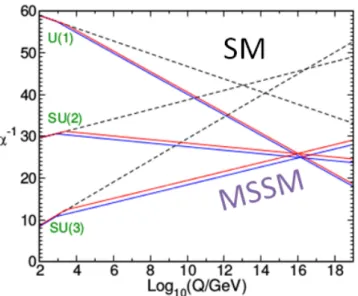
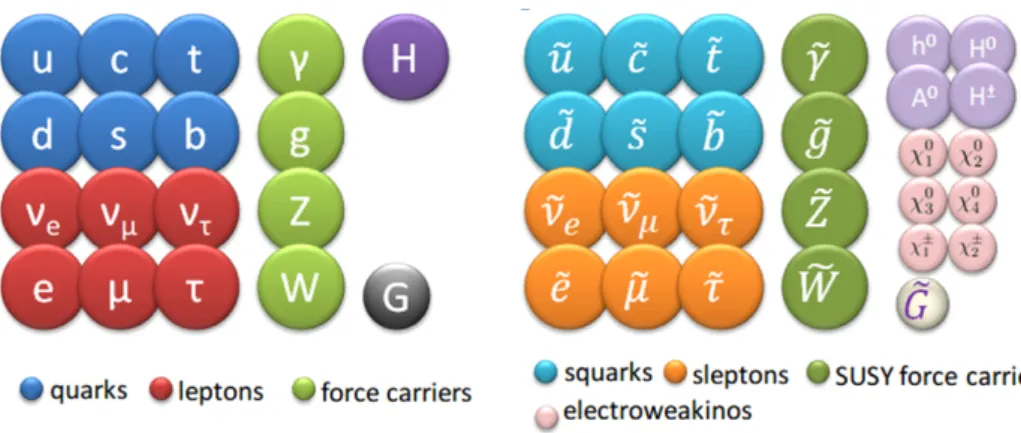
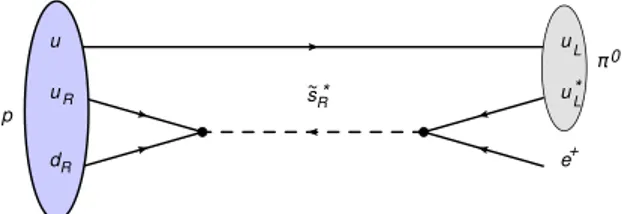
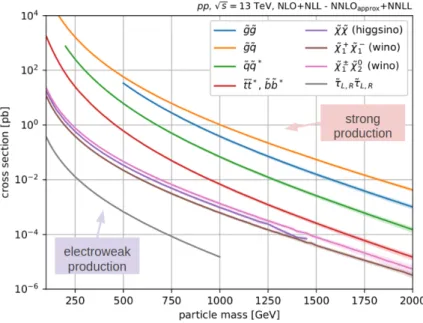
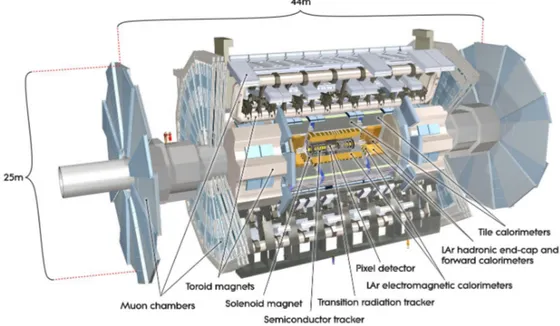
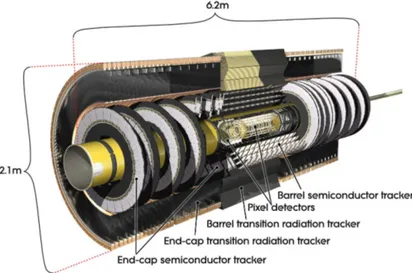
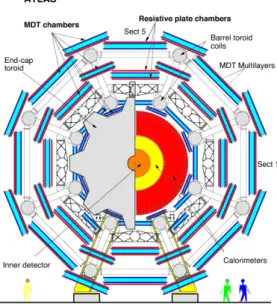
![Figure 2.4: Delivered luminosity to ATLAS for pp collisions versus time for years 2011- 2011-2018 [46].](https://thumb-eu.123doks.com/thumbv2/1library_info/3998628.1540306/23.892.207.602.176.500/figure-delivered-luminosity-atlas-collisions-versus-time-years.webp)
